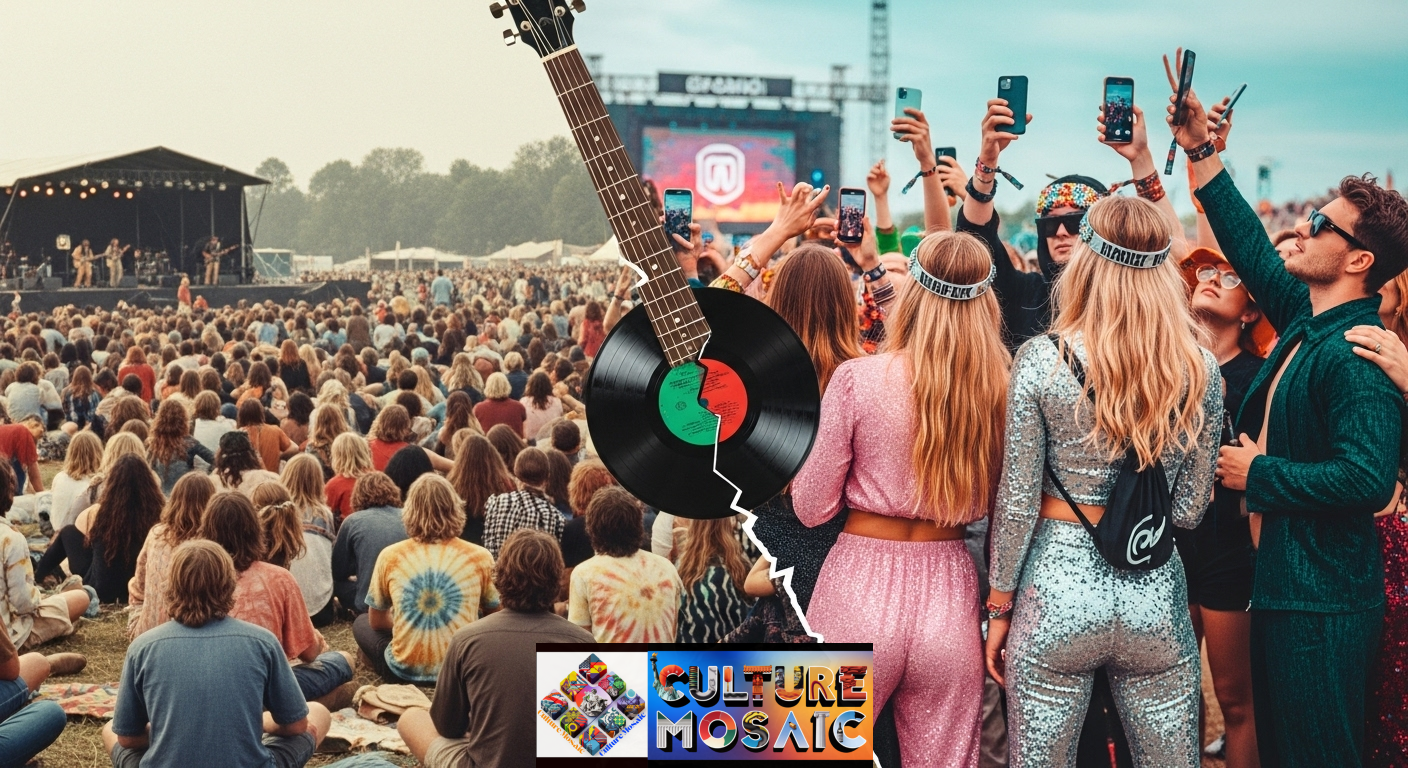Festival culture isn’t what it used to be. What started as spontaneous gatherings celebrating music and freedom has morphed into something entirely different. Today’s major festivals feel less like cultural movements and more like carefully orchestrated marketing campaigns where the experience itself has become secondary to the content it generates.
Walk through Coachella or Lollapalooza today, and you’ll notice something striking. For every person watching the stage, there’s someone with their back to the performance, posing for the perfect Instagram shot. The question isn’t whether you enjoyed the music anymore. It’s whether you got the content to prove you were there.
This transformation didn’t happen overnight. Festival culture evolved gradually from its countercultural roots into today’s influencer-dominated, brand-sponsored spectacles. Understanding this shift reveals something bigger about how we consume experiences in the digital age.
The Original Festival Culture: When Music Actually Mattered Most
Festival culture in America began as a genuine rebellion. Woodstock in 1969 wasn’t about branding or social media clout. It was about 400,000 people gathering in a muddy field because the music and the moment mattered more than comfort or aesthetics.
The festivals of the 1960s and 70s emerged from counterculture movements. They represented freedom, artistic expression, and community. People attended to hear musicians who challenged the status quo, to connect with like-minded individuals, and to experience something authentic. The photographs from these events captured real moments, not manufactured ones.
Even into the 1990s and early 2000s, festival culture maintained some of this spirit. Events like Bonnaroo and early iterations of Coachella focused primarily on music diversity and artistic curation. Sure, there were sponsors, but they weren’t the main event. The lineup was what drew crowds, and the experience was about discovering new artists and losing yourself in the music.
That version of festival culture feels almost quaint now.
When Festival Culture Became an Influencer Playground
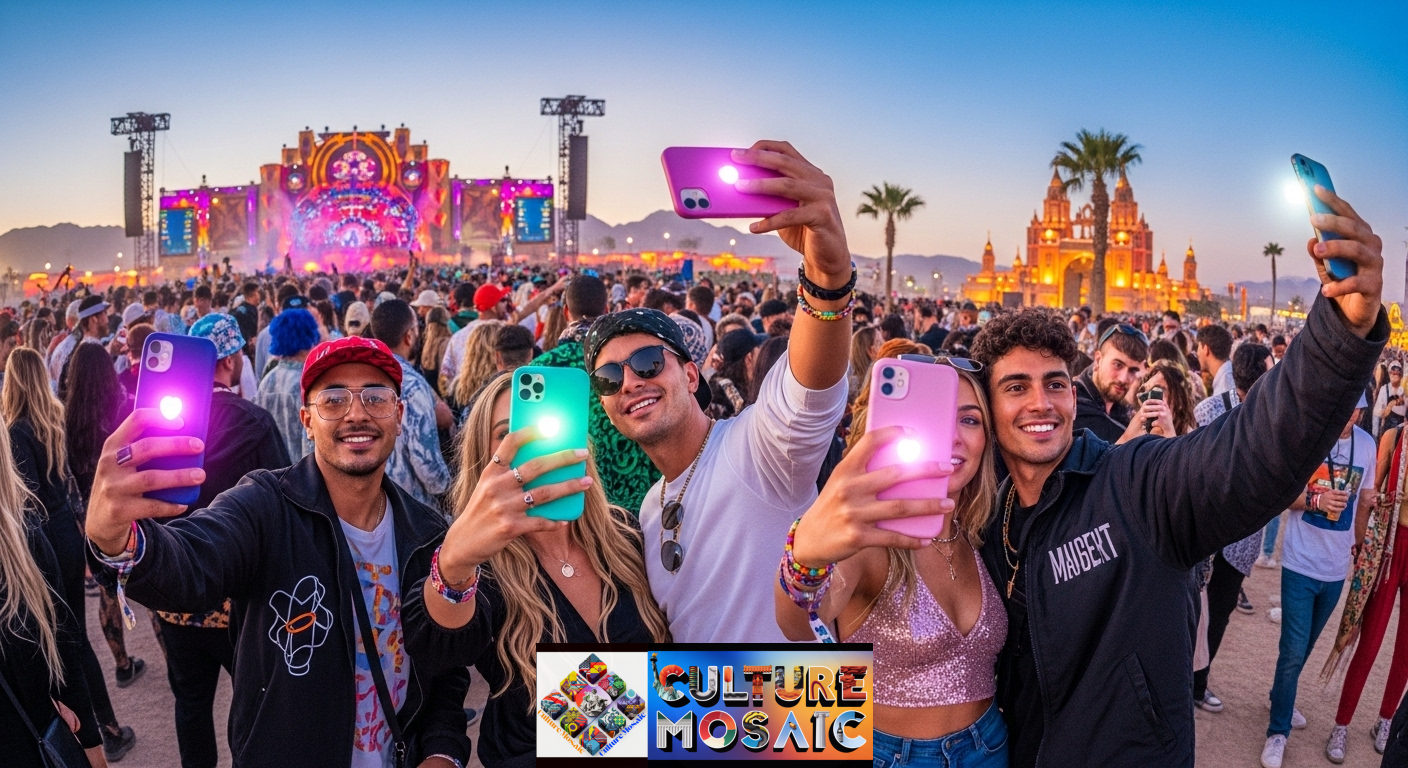
The shift in festival culture accelerated around 2010 when Instagram launched. Suddenly, festivals weren’t just events to attend. They were backdrops for personal branding.
Coachella became the inflection point. What was once a respected music festival in the California desert transformed into the Super Bowl of influencer marketing. Brands realized festival culture offered something valuable: access to young, engaged audiences who were already primed to share content.
The math was simple. Pay influencers to attend, give them VIP experiences, outfit them in sponsored gear, and watch as they broadcast the brand message to millions of followers. Festival culture became the perfect vehicle for what marketers call “experiential advertising.” The festival itself was the product, and attendees were both consumers and unpaid promoters.
This fundamentally changed why people go to festivals. A 2023 survey found that 67% of festival attendees under 30 cited “getting content for social media” as a primary reason for attending. The music ranked third.
The Two-Tier Reality of Modern Festival Culture
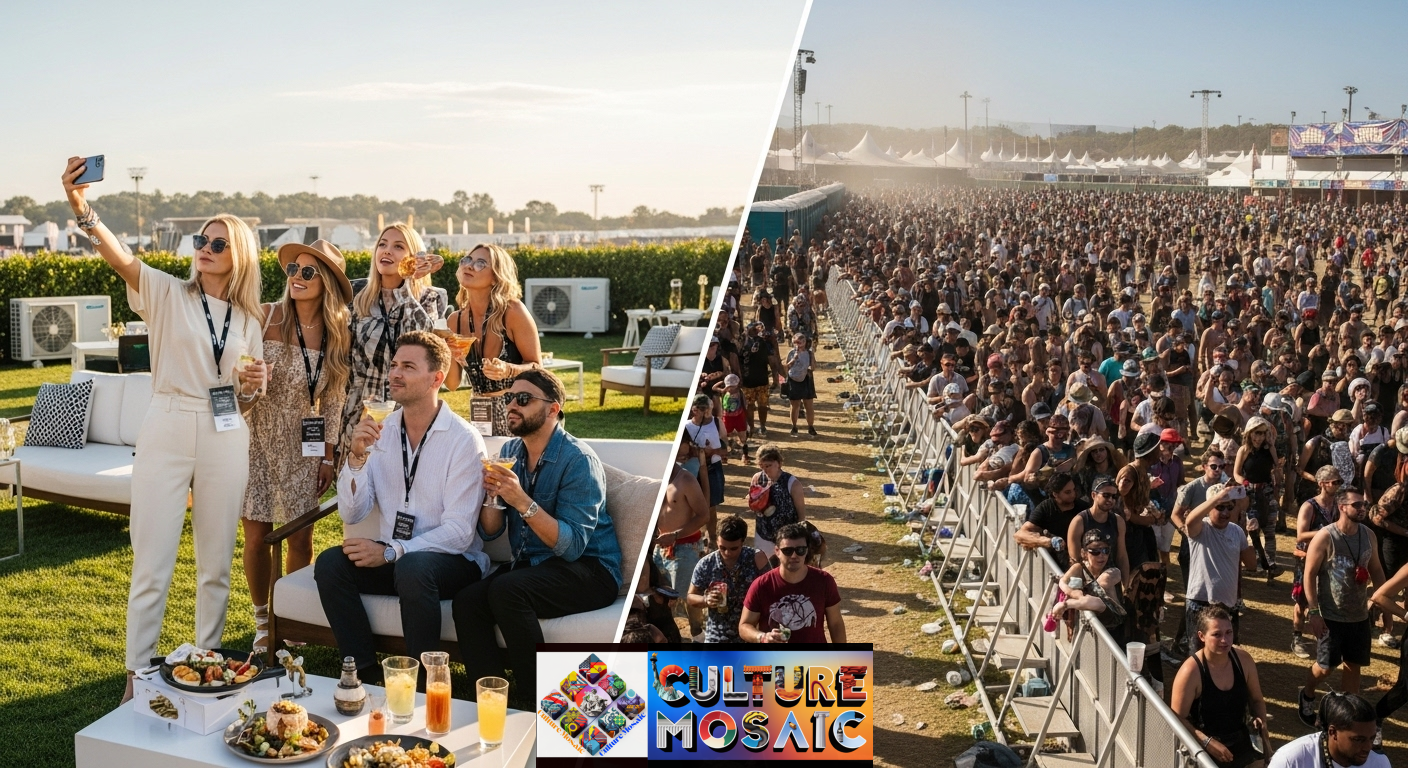
Today’s festival culture operates on two completely different planes, and the gap between them tells you everything about where we are as a society.
On one level, there’s the influencer experience. Free flights, luxury accommodations, backstage passes, gifted outfits from fashion brands, and access to exclusive VIP areas with air conditioning and gourmet food. These festival-goers attend on someone else’s dime, creating content that makes the event look like a glamorous paradise.
Then there’s everyone else. The regular attendee pays $400+ for a general admission ticket, another $150 for parking and shuttles, $200 for basic camping or nearby lodging, and $100+ for food and drinks once inside. They stand in the heat, wait in long bathroom lines, and watch performances from hundreds of feet away while fighting through crowds of people more interested in filming than listening.
This economic divide within festival culture mirrors broader wealth inequality, but it’s packaged as aspirational content. The message is clear: if you’re not in the VIP section, you’re not doing it right. This creates a cycle where people stretch their budgets to attend festivals they can barely afford, hoping to capture that one perfect moment that makes it look worth it.
The average cost for attending a major festival has increased 127% since 2010, while the median income for Americans aged 18-34 has risen just 19% in the same period. Festival culture has become a luxury product marketed as an essential youth experience.
Festival Fashion: The Wasteful Trend Nobody Wants to Talk About
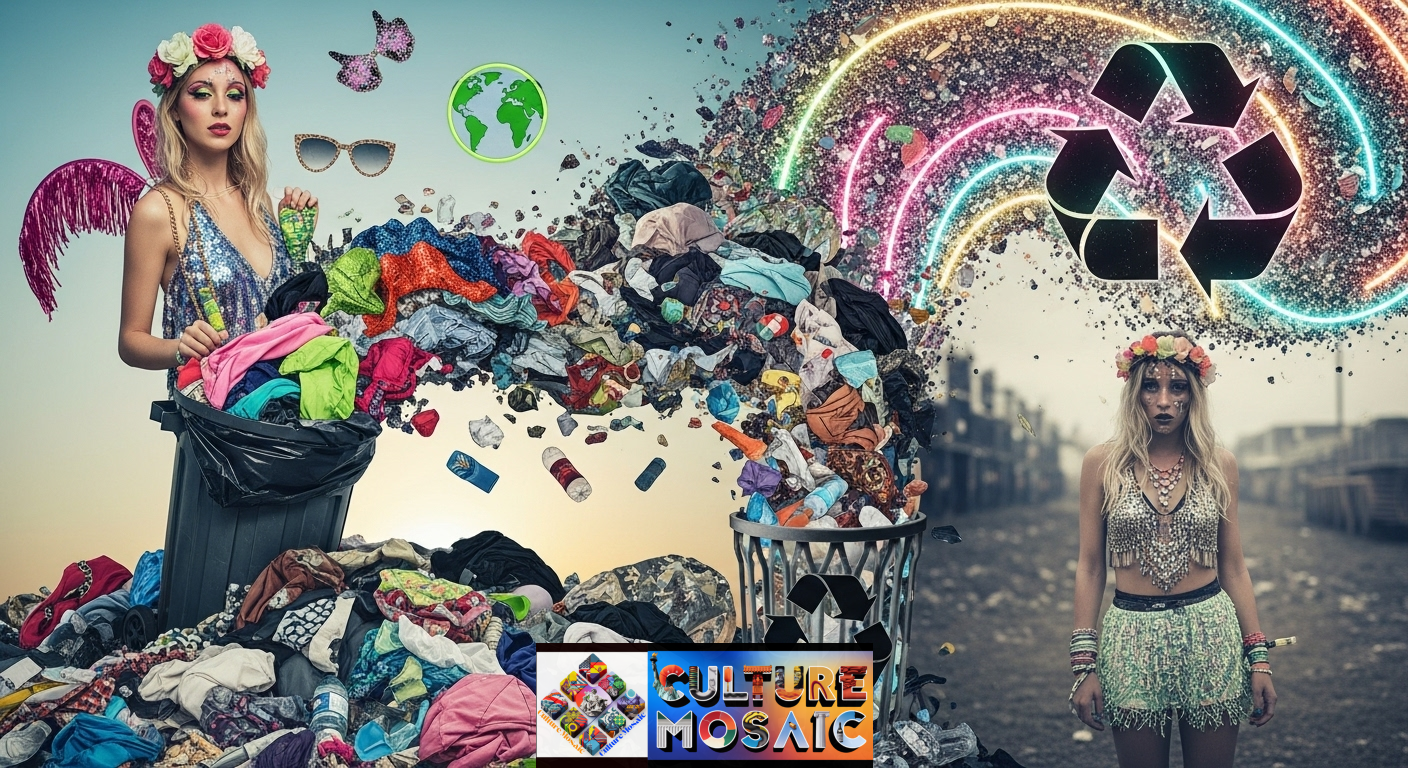
Festival culture’s environmental impact extends beyond the obvious trash left behind. The real damage happens in your closet.
Fast fashion brands discovered that festival season represented a massive opportunity. They started churning out cheap, trendy “festival wear” designed to be worn once, photographed extensively, and discarded. Sequined tops, fringe vests, flower crowns, glitter, neon accessories—all manufactured overseas, shipped globally, worn for a weekend, and tossed.
A 2024 study estimated that festival fashion generates over 45,000 tons of textile waste annually in the US alone. Most of these items are made from synthetic materials that won’t biodegrade for centuries. Festival culture, which once represented freedom and connection to nature, now contributes significantly to environmental destruction.
The irony isn’t lost on festival-goers themselves. Many express guilt about buying new outfits for every event, but festival culture’s social media component creates enormous pressure to never repeat looks. If you posted yourself in that outfit at Coachella, you can’t wear it to Bonnaroo. The algorithm remembers.
Some positive shifts are emerging. Rental services for festival fashion have gained traction, and thrifting for festival outfits has become trendy. But these sustainable choices still represent a minority of festival culture. Most attendees still buy new, cheap, disposable clothing because it’s easier and often less expensive upfront than sustainable alternatives.
The TikTok Effect: When Content Creation Becomes the Point
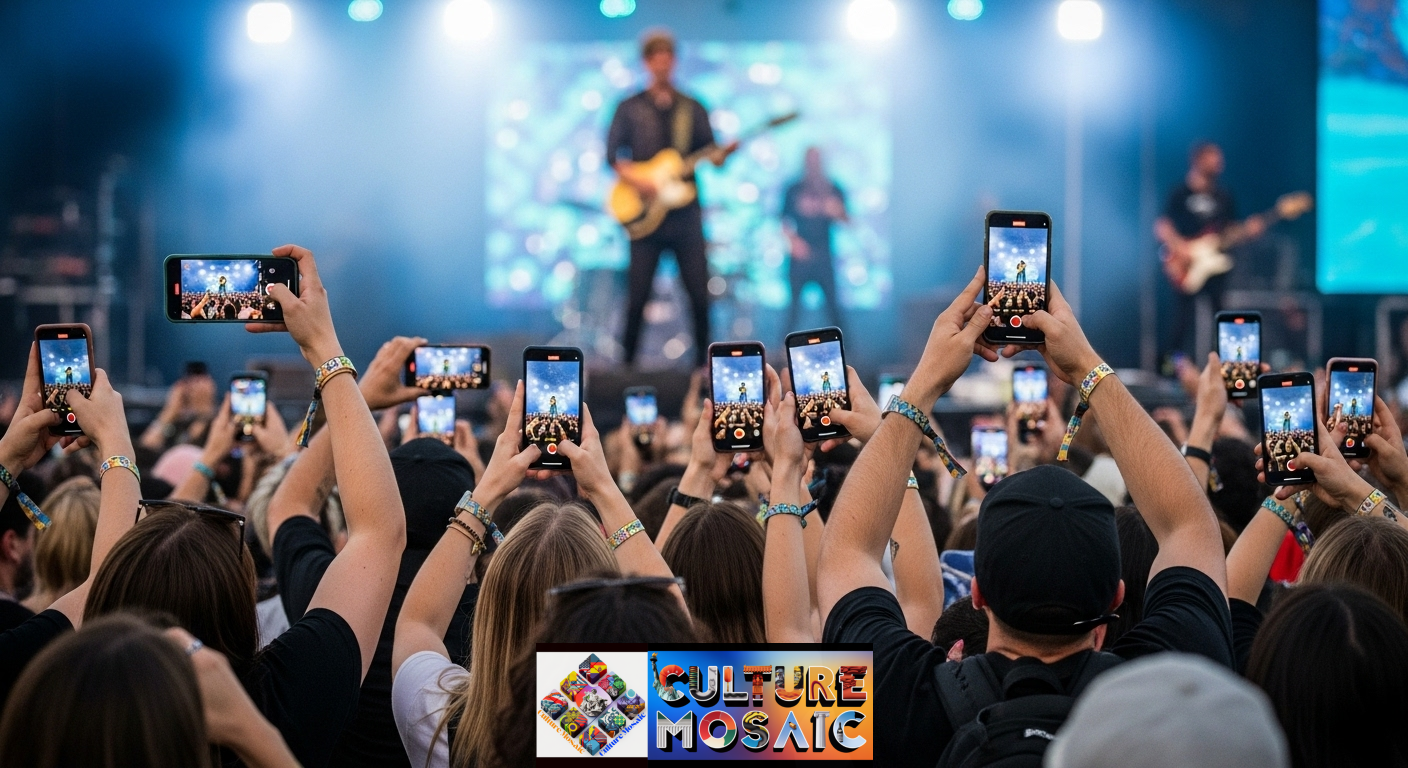
TikTok didn’t just change festival culture. It fundamentally rewired what festivals are for.
Previous social platforms encouraged sharing highlights. TikTok demands constant content creation. This shift means festival attendees now approach events as multi-day filming locations rather than musical experiences. The goal is to gather enough content to feed your social media presence for weeks afterward.
Watch people at any major festival, and you’ll see the same behavior repeated thousands of times. Someone poses for 30 seconds of video, checks the playback, adjusts their positioning, and shoots it again. They might do this 15 times until they get the perfect clip. Meanwhile, the artist they supposedly came to see is performing behind them.
Festival culture now rewards documentation over participation. The worst thing isn’t attending a festival. It’s attending and having nothing to show for it. If you don’t capture content, did you even go?
This creates a strange disconnect. People report feeling exhausted and unsatisfied after festivals, despite their social media suggesting they had the time of their lives. The pressure to constantly create content means you can never fully immerse yourself in the moment. You’re always half-performing, half-experiencing.
Younger generations seem aware of this tension but feel powerless to resist it. Festival culture has become so intertwined with social media validation that opting out feels like social suicide. You attend festivals to maintain relevance, not necessarily because you want to.
Corporate Sponsorship: Who Really Benefits from Festival Culture?
Follow the money, and festival culture looks less like a cultural celebration and more like an advertising convention.
Major festivals now generate more revenue from sponsorships than ticket sales. Brands don’t just put their logos on stages anymore. They create entire “brand experiences” within the festival grounds. Heineken houses, American Express lounges, Mercedes-Benz viewing platforms—festivals have become three-dimensional advertisements where the music is just the bait.
This corporate infiltration of festival culture raises questions about authenticity. When a festival is primarily funded by alcohol companies, tech brands, and credit card companies, whose interests are really being served? The answer becomes obvious when you look at festival demographics. Organizers deliberately target affluent young adults with disposable income—the exact audience corporate sponsors want to reach.
The festival-industrial complex works like this: Corporations sponsor events, paying influencers to attend and promote both the festival and their products. These influencers create aspirational content that makes regular people want to attend. Those regular people buy expensive tickets, and a portion of that money goes back to corporations through sponsorship deals. Everyone profits except the average attendee, who goes home broke but with good photos.
Some artists have pushed back against this corporate takeover of festival culture. They refuse to play certain sponsored stages or speak out about the commercialization. But they’re fighting enormous economic pressure. For many musicians, festival slots represent crucial income and exposure. The system isn’t easy to resist from the inside.
The Sustainability Reckoning in Festival Culture
Festival culture’s environmental impact finally became impossible to ignore. Beyond fashion waste, there’s the carbon footprint of tens of thousands of people traveling to remote locations, the massive amounts of single-use plastics, the diesel generators running 24/7, and the destruction of natural spaces.
Some festivals have started implementing sustainability measures. Bonnaroo introduced composting programs. Lightning in a Bottle requires attendees to sort their waste. Coachella installed water refill stations to reduce plastic bottles. But critics argue these efforts are performative—minor gestures that don’t address the fundamental unsustainability of festival culture itself.
The real question nobody wants to ask: Can festival culture exist sustainably at this scale? When 100,000 people descend on a location for a weekend of maximum consumption and waste generation, can any amount of recycling bins and solar panels offset that impact?
Younger festival-goers increasingly grapple with this cognitive dissonance. They care about climate change but also want to participate in festival culture. They buy reusable bottles but also travel hundreds of miles by plane. They criticize corporate sponsors but accept free branded merchandise.
Festival culture might need fundamental restructuring to become truly sustainable. That could mean smaller events, more regional festivals to reduce travel, stricter waste requirements, or dramatically different approaches to food and infrastructure. But such changes would likely make festivals less profitable and less Instagram-worthy—two qualities that currently define the industry.
What Festival Culture Reveals About Modern American Values
Step back from the specifics, and festival culture becomes a mirror reflecting what we’ve become. We value appearance over substance. We prioritize content creation over lived experience. We accept economic inequality as long as it’s aesthetically pleasing. We want to appear environmentally conscious without making real sacrifices.
Festival culture shows how capitalism adapts and absorbs everything, even movements that started as rebellion against commercialization. The counterculture aesthetics remain—the bohemian fashion, the talk of community and freedom—but they’ve been hollowed out and filled with corporate messaging.
This isn’t to say everyone who attends festivals is shallow or complicit. Most people genuinely love music and want to have fun with friends. But the infrastructure of modern festival culture pushes everyone toward performance and consumption, whether they want that or not.
The saddest part might be how festival culture represents missed potential. These events could be spaces for genuine community building, artistic experimentation, and cultural exchange. Instead, they’ve become expensive photo shoots where the line between attendee and advertisement has completely dissolved.
Where Festival Culture Goes From Here
Festival culture stands at a crossroads, though it’s unclear which path the industry will choose. Growing awareness of these issues hasn’t yet translated into significant change. Festivals are more expensive, more crowded, and more commercialized than ever.
Some alternatives are emerging. Smaller, independent festivals focus on music and community over branding. Some events ban professional photography equipment to discourage content creation obsession. Others implement strict sustainability requirements or cap attendance to reduce environmental impact.
But these alternatives exist at the margins of festival culture. The major events that define the industry continue growing larger and more corporate each year. As long as people keep buying tickets and creating content, there’s little incentive for fundamental change.
Perhaps the real shift needs to happen in how individuals approach festival culture. Attending with different priorities—actually watching performances, connecting with people face-to-face, leaving your phone in your pocket—represents a form of quiet rebellion against what festivals have become.
Festival culture will likely continue evolving based on which generation holds economic power. Gen Z shows some signs of rejecting influencer culture’s excesses, but they’re also the most digitally native generation. Will they reclaim festivals as genuine musical experiences, or will they find new ways to monetize and perform authenticity?
The answer matters because festival culture says something about how we experience joy, community, and art in modern America. Right now, the story it tells isn’t particularly encouraging.
Frequently Asked Questions About Festival Culture
How much does the average person spend attending a major music festival?
The average attendee at a major US festival spends between $800-1,500 for the weekend. This includes tickets ($300-600), travel ($100-300), accommodation ($150-400), food and drinks ($150-300), and festival fashion or gear ($100-200). VIP tickets and experiences can push costs above $3,000.
Why has festival culture become so focused on social media content?
Festival culture shifted toward content creation because platforms like Instagram and TikTok reward visually striking experiences with engagement and social validation. Festivals provide perfect backdrops for content, and brands began sponsoring influencers to promote events. This created a cycle where attending festivals became as much about gathering content as enjoying music.
Are music festivals actually bad for the environment?
Yes, festivals have significant environmental impacts. They generate massive waste from single-use items, food, and disposable festival fashion. They require extensive travel by attendees, produce carbon emissions from power generation, and often damage natural spaces. While some festivals implement sustainability programs, most experts agree that the current scale and model of festival culture isn’t environmentally sustainable.
What’s the difference between regular tickets and influencer experiences at festivals?
Influencers typically receive free entry, VIP or backstage access, complimentary accommodations and travel, gifted outfits and products from sponsors, access to exclusive areas with better amenities, and sometimes direct payment to attend and create content. Regular ticket holders pay full price for general admission, stand in regular crowds, and access only standard festival amenities.
Is festival culture changing as people become more aware of these issues?
Slowly. There’s growing awareness about festival culture’s problems—the cost, the environmental impact, the performative nature of social media content. Some smaller festivals emphasize sustainability and authentic musical experiences. However, major corporate festivals continue growing more expensive and commercialized. Real change depends on whether enough people vote with their wallets and demand different festival experiences.

